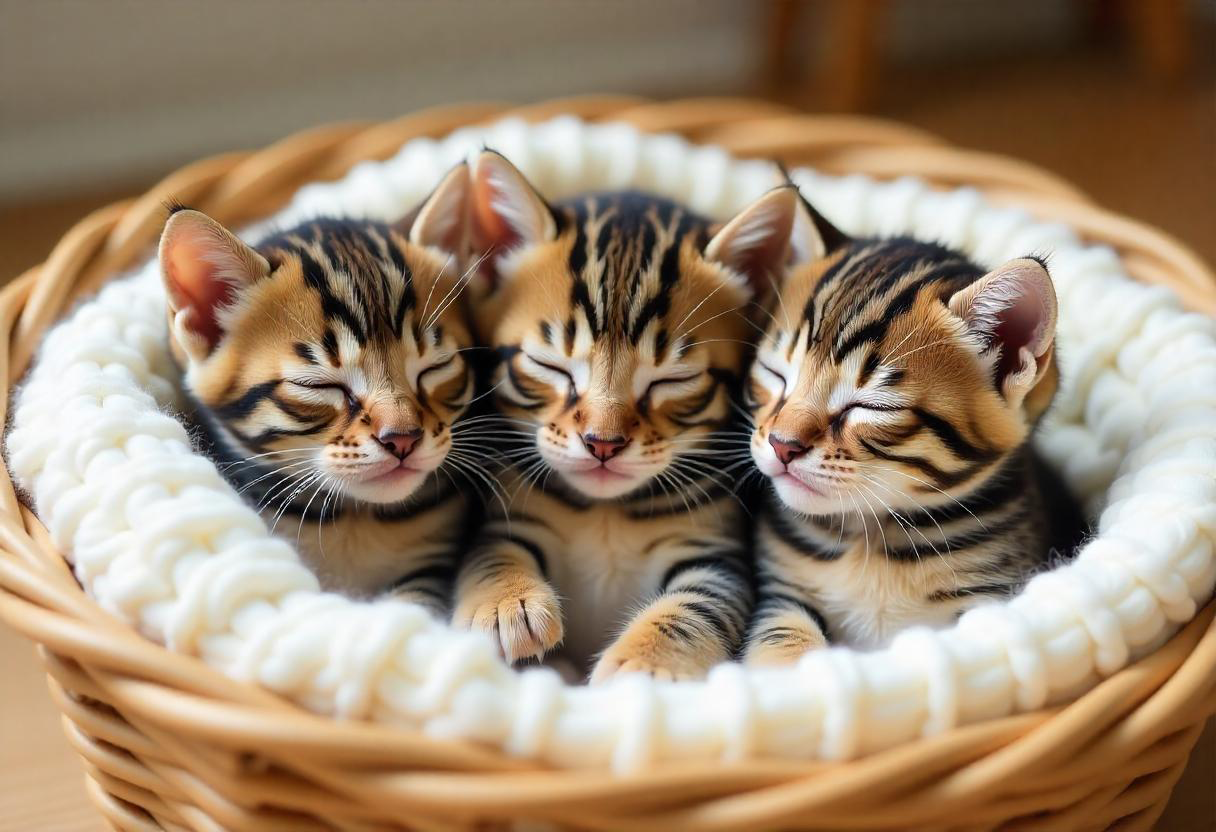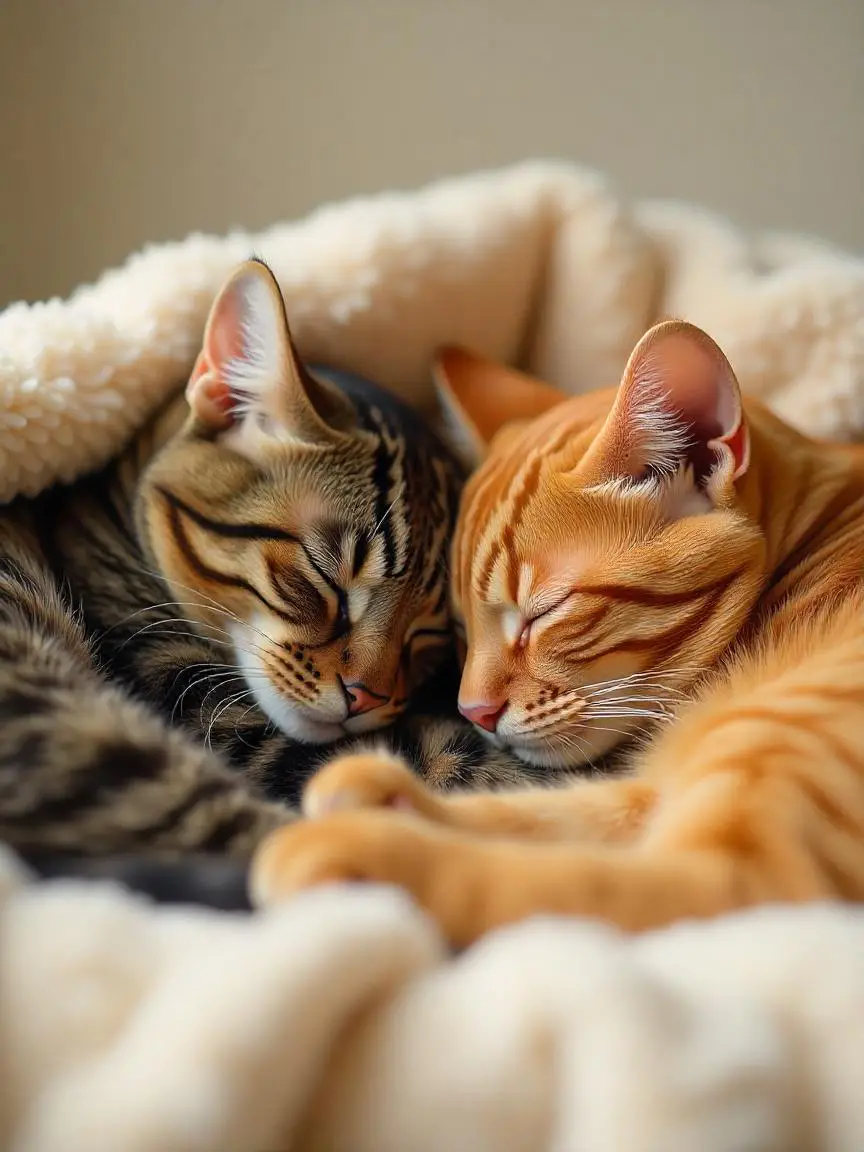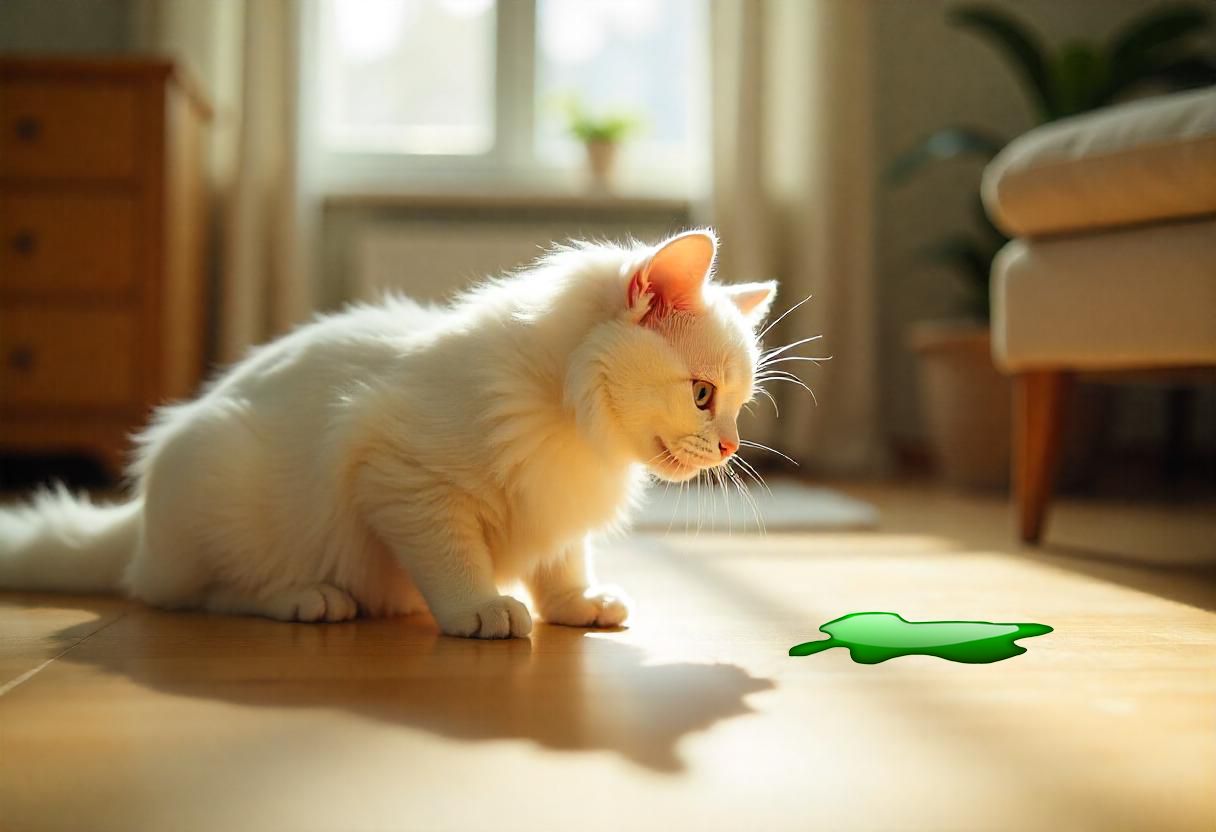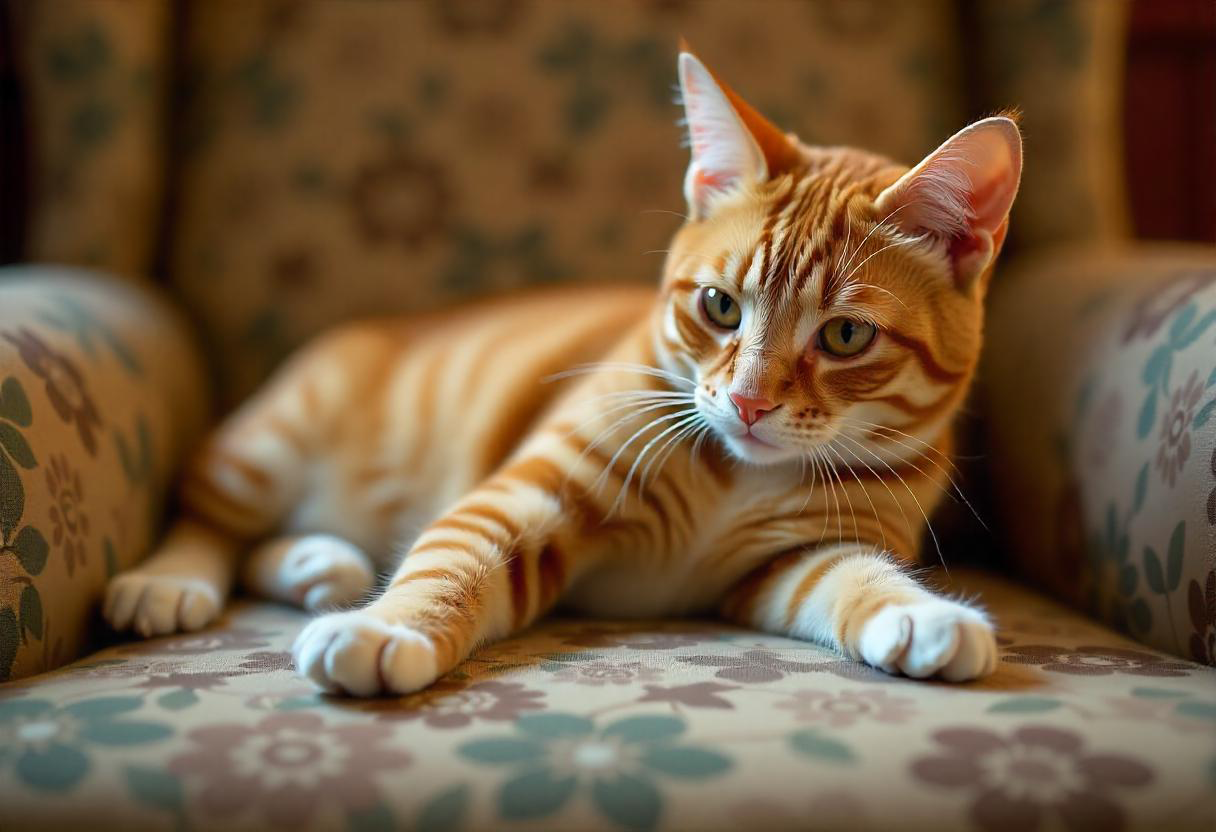Cats are great at hiding when something’s wrong—but their sleeping positions can give you subtle clues. If your cat is curled up tightly, hunched over with a raised back and lowered head, it could be a sign they’re trying to cope with pain or discomfort.
But sleep posture alone doesn’t always tell the full story. To understand if your cat might be feeling sick, it’s important to look at the full picture, including changes in behavior and energy levels.
Let’s explore the most common sleeping positions cats show when they’re unwell, and the signs you should never ignore.
Cat Sleeping Positions That May Indicate Sickness
When your cat isn’t feeling their best, they might change how they sleep to ease discomfort or protect themselves. While some positions may look normal, they can actually signal that something isn’t quite right.
1. Curled Up in a Tight Ball
It’s common for cats to curl up when they sleep—but if your cat is unusually tense, with their head tucked tightly into their body and paws wrapped in, it might be a sign they’re trying to conserve body heat or protect a sore area.
This position could indicate pain, fever, or overall weakness. If you notice this alongside low energy, loss of appetite, or hiding behavior, it’s time to pay attention.
Always get your cat checked by a vet to be sure of what’s going on. A proper diagnosis will help your cat feel better sooner.
2. Lying Flat on Their Back
What it looks like:
Your cat is stretched out on their back, belly exposed, with paws relaxed. It often looks adorable—and if your cat is normally trusting and affectionate, it can simply mean they’re comfortable around you.
What It Might Mean & How to Help:
-
Overheating:
This position helps them release body heat. If the weather is hot, your cat may be trying to cool down. Offer a cooling mat, shade, and plenty of water. A quiet room with a fan can also help.
But be cautious—too much heat can lead to heatstroke.Warning signs of heatstroke include:
-
Panting or open-mouth breathing
-
Weakness or tiredness
-
Vomiting or diarrhea
-
Red or inflamed gums
-
Trouble walking
-
Collapse or unconsciousness
If you see any of these, call your vet right away—heatstroke is an emergency.
-
-
Stress:
Sometimes, cats lie on their back with claws slightly extended. This posture gives them quick access to their defenses and may signal they feel unsafe. Try to remove loud noises, unfamiliar guests, or other stressors to help them feel more secure.
3. Lying Flat on Their Stomach
What it looks like:
Your cat is stretched out on their belly with their legs spread out—this is often called the “sploot” position.
What It Might Mean & How to Help:
-
Muscle Stretching:
This position can simply be a relaxing stretch for the back legs or hips. It’s usually nothing to worry about unless they also show signs of stiffness or limping. -
Cooling Down:
If they’re lying like this on a cool surface, they might be trying to regulate their body temperature. Make sure the room stays cool and keep fresh water available at all times.
If your cat seems stiff or avoids movement, consider a vet visit to rule out joint or muscle issues.
4. Cat Loaf Position
What it looks like:
Your cat is sitting upright with all paws neatly tucked under their body—resembling a loaf of bread.
What It Might Mean:
Most of the time, this is a perfectly normal and cozy position. It usually means your cat feels safe and calm.
-
But in some cases, it could signal discomfort in the paws. If your cat stays like this for too long or avoids walking, check for:
-
Ingrown nails
-
Small wounds or cuts
-
Debris or foreign objects stuck in the paw
-
A quick paw inspection can help you catch small issues early.
5. Meatloaf Position (with Head Down)
What it looks like:
Similar to the loaf, but more hunched—your cat’s body is tight, paws are hidden, and their chin is resting on the floor.
What It Might Mean & Why It’s Serious:
-
Chronic Illness (like Kidney Disease):
If your cat spends a lot of time in this position and also seems tired or drinks excessive water, they could be dealing with chronic kidney disease (CKD). -
End-of-Life Signs / Senior Cat Discomfort:
Older or severely ill cats may rest like this when they’re in serious pain or approaching the end of life. This position is commonly seen in cats who are very unwell and need urgent care.
If your cat shows these signs—especially alongside lethargy, loss of appetite, or unusual drinking habits—get in touch with your vet right away. Early action can reduce their pain and possibly improve their condition.
6. Sleeping on Their Side
What it looks like:
Your cat is stretched out comfortably on their side, legs extended, looking completely relaxed. This is one of the most common and peaceful cat sleeping positions.
What It Might Mean & When to Be Concerned:
-
Relaxation:
Most of the time, this just means your cat feels safe and content. Side sleeping allows them to fully rest without feeling threatened. -
Breathing Trouble:
However, if they’re lying on their side and you notice wheezing, rapid breathing, or labored breaths, this could be a sign of respiratory distress. Don’t ignore it—schedule a vet visit to rule out any serious lung or heart issues.
7. Sleeping With One Eye Open
What it looks like:
Your cat appears to be asleep, but one eye stays slightly open. This can happen in almost any position.
What It Might Mean & How to Respond:
-
Natural Instinct:
This behavior is part of a cat’s unique sleep pattern called unihemispheric slow-wave sleep. It allows them to rest one half of their brain while staying alert with the other—especially in unfamiliar or noisy surroundings. -
Possible Eye Problem:
If your cat consistently keeps one eye closed even while awake, it might point to a medical issue. Look for signs like:-
Excessive blinking or squinting
-
Watery or colored eye discharge
-
Redness or swelling around the eye
-
These signs could mean anything from mild irritation to an infection, so a vet checkup is best.
-
Illness Monitoring:
Some sick cats avoid deep sleep because they want to stay alert—especially if they’re uncomfortable or having trouble breathing. In that case, sleeping with one eye open could be a sign your cat isn’t feeling well and needs medical care.
8. Head Pressing
What it looks like:
Your cat leans forward and presses their head firmly against a wall, floor, or other solid surface. This is not to be confused with affectionate headbutting—they won’t rub their scent glands or seek attention. Instead, they stay still or even fall asleep in this face-down position.
What It Might Mean & Why It’s Serious:
-
Serious Illness Alert:
Head pressing is often a symptom of serious neurological or metabolic conditions, such as hepatic encephalopathy, brain tumors, or poisoning.
If you see your cat doing this, get veterinary help immediately. This isn’t a behavior to wait and watch—it needs urgent attention and testing to determine the cause.
Sleeping Habits That May Signal Illness
When it comes to spotting sickness in cats, it’s not just the position they sleep in—but also how and where they sleep that can offer important clues.
1. Sleeping With Other Cats
Cats are naturally independent sleepers. So, if your normally private cat chooses to curl up next to another cat—especially while showing signs of weakness or discomfort—it could be their way of seeking protection or comfort.
This behavior is rare, as most cats don’t like showing vulnerability. If your cat suddenly becomes more clingy with others while resting, it might be their subtle cry for help.
2. Always Sleeping in the Same Spot or Position
If your cat insists on lying down in the exact same place or position every time—without moving much—it might be because they’ve found a spot that feels safest or least painful.
While cats are creatures of habit, this kind of repetitive behavior may suggest they’re avoiding movement due to discomfort. Monitor for other signs like stiffness, limping, or changes in appetite.
3. Sleeping Too Much
Cats already sleep a lot—usually around 12 to 16 hours a day. But if your cat starts sleeping more than 16 hours, and struggles with getting up, walking, or even shifting positions, it may be a sign that they’re not feeling well.
Fatigue paired with other symptoms like lack of interest in food, hiding, or sluggish movement is worth getting checked by your vet.
Frequently Asked Questions
How can I tell if my cat’s sleeping position means they’re sick?
Some sleeping positions—like the meatloaf position with head down, or being curled up tightly and tense—may suggest discomfort or pain. While many sleeping styles can be normal, it’s important to look for additional signs like lethargy, appetite loss, or unusual behavior. A sudden change in how or where your cat sleeps could be a subtle sign something’s not right.
Is it normal for my cat to sleep more than 16 hours a day?
Cats are big sleepers, but consistently sleeping more than 16 hours—especially if paired with low energy, difficulty moving, or a change in behavior—can be a red flag. It may indicate illness, so keep an eye on your cat and consider a vet visit if it continues.
What does it mean if my cat is sleeping in the same spot all the time?
Cats like cozy spots, but if your cat chooses the exact same position or place every time, they may be trying to avoid pain or minimize movement. This could be a sign of joint discomfort, muscle soreness, or even a deeper health issue. Watch for stiffness or hesitation when walking.
Why is my cat sleeping with one eye open?
Cats naturally rest with one eye open during light sleep—it’s part of their survival instinct. However, if one eye stays closed even when they’re awake, or you notice redness, discharge, or excessive blinking, it might point to an eye infection or irritation that needs attention.
Is head pressing while sleeping always serious?
Yes, head pressing is different from affectionate headbutts. If your cat is pushing their head against a surface and staying like that—especially while resting or sleeping—it can be a symptom of serious conditions like neurological issues or liver disease. This requires immediate veterinary care.












